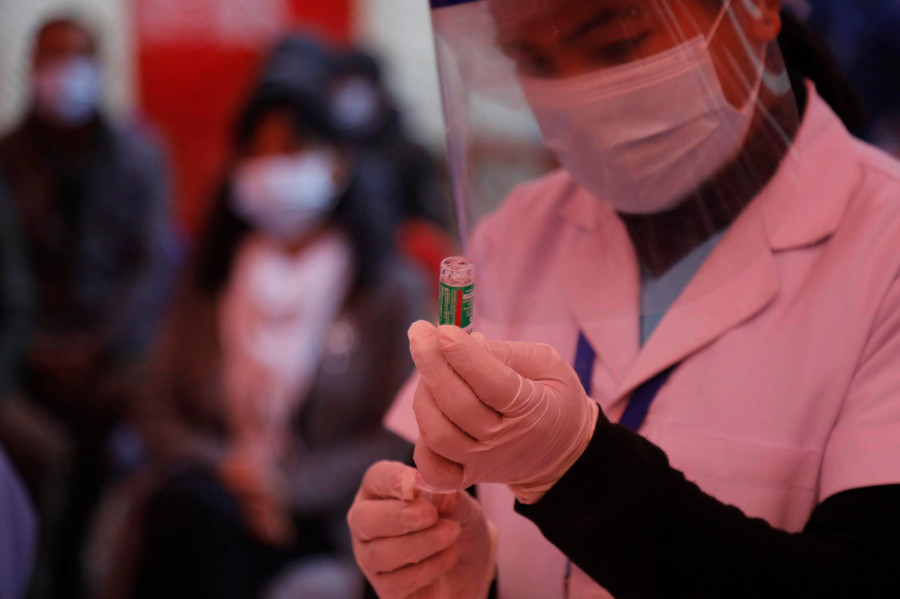Health
Plans are in place to procure more jabs, but management is key, experts say
The government plans to procure 42 million additional doses of Covid-19 vaccines by mid-February. But challenges remain in their storage, deployment and administration.
Arjun Poudel
If everything goes according to the plan the Ministry of Health and Population has made, over 42 million additional doses of various Covid-19 vaccines will arrive by mid-February next year and all Nepalis over 12 years will be inoculated by mid-April.
Public health experts as well as former bureaucrats the Post talked to welcomed the likelihood of vaccine supply getting smoother in the coming months but stressed the need for management of their storage and deployment across the country.
The problems are internal management of the vaccines, storage issues, management of the immunisation centres and awareness drive about the importance of getting vaccinated, according to them.
“Proactive internal planning is required. Necessary infrastructures of the storage should be prepared before the vaccines arrive. Work, therefore, should begin on a war footing,” Dr Shyam Raj Upreti, coordinator of Covid-19 Vaccine Advisory Committee, told the Post. “All the ongoing problems of mismanagement should be addressed and reporting and data collection systems should be made effective.”
Nepal has so far received over 9.782 million doses of various Covid-19 vaccines—it bought 5 million doses and over 4.782 million doses were provided in grants by different countries.
According to the ministry, 10.2 million doses will arrive by mid-October.
This includes 3.2 million doses that Japan and China have assured in grants—1.6 million doses of AstraZeneca from Japan through the COVAX facility and 1.6 million doses of Vero Cell from China.
Apart from this, 6 million doses of Vero Cell vaccine will also come during this period, which the government is buying with the manufacturing company, Sinopharm, through a non-disclosure agreement.
The Health Ministry also expects the delivery of 1 million doses of Covishield, the brand name under which the Serum Institute of India is marketing the AstraZeneca vaccine, which it paid for in February. India has banned the export of vaccines after the second wave hit the country in March.
In a planning estimate the Health Ministry made public on Monday, the government has already paid for 4 million doses of the Moderna vaccine through the World Bank to the US manufacturer of the vaccine, and delivery is expected by mid-February.
Also expected by mid-February is 11 million doses from the COVAX facility through a cost-sharing mechanism, which means the government will pay to the COVAX facility the amount equivalent to what it paid to the manufacturing company.
Besides that, the COVAX facility will provide another 11.3 million doses in grant.
Talks are also underway to secure a deal to purchase 6 million doses of Pfizer- BioNTech vaccine for children aged 12 to 18 years.
According to Upreti, storing and administering the Pfizer-BioNTech and Moderna vaccines will be particularly challenging.
Nepal’s existing vaccine storage infrastructure—built for childhood immunisation programmes—allows vaccines to be stored at 2 to 8 degrees Celsius. But Pfizer-BioNTech and Moderna vaccines require ultra-low temperatures between -50 degrees and -70 degrees Celsius for storage up to six months.
According to Upreti, Pfizer-BioNTech and Moderna vaccines can be kept in the container that they are transported in for a month but dry ice should be kept outside the container constantly. The vaccine can be stored for a month in temperatures between 2 and 8 degrees Celsius and for another two weeks in a freezer at temperatures between -20 and -25 degrees Celsius.
“Work is underway to set up ultra-low temperature storage in all seven provinces,” said Dr Jhalak Gautam, chief of the National Immunisation Programme.
Experts say that if the vaccines arrive as planned, administering them should not be an issue.
“What is important is that the vaccines should come,” Dr Bikash Lamichhane, former chief of the National Immunisation Programme, told the Post. “Vaccines can be sent to districts within one month after all the necessary preparations for inoculation are in place.”
But the mismanagement evident during the ongoing vaccination campaign, like the vaccination centres running out of vaccines and crowds at immunisation centres, should be addressed immediately, they said.
The number of immunisation centres should be increased, said Dr Keshab Deuba, a public health epidemiologist.
“Why are we operating only a certain number of immunisation centres when we can run a lot more and address the crowds we see now?” Deuba told the Post. “Uptake of the vaccine at present is very high which is a good thing but authorities should make every effort to inoculate the maximum number of people at the earliest.”
So far, 4,163,251 people have taken the first dose of vaccine and 2,000,211 people have been fully immunised against Covid-19, since Nepal began its vaccination campaign on January 27, according to the latest Health Ministry data.
Besides the management of inoculation centres, awareness programmes also need to be launched despite the fact that the vaccine acceptance rate is very high among Nepalis, according to Dr GD Thakur, former director at the Epidemiology and Disease Control Division.
“When a certain percentage of the population is inoculated, the vaccine uptake rate may not remain the same,” Thakur told the Post. “We have read news of the American government offering marijuana and a $100 incentive for vaccinations. We may not have to offer such things but we need to start an awareness campaign and give a message about the importance of being inoculated.”
Studies have projected that a certain threshold of inoculated population is necessary for Covid-19 to be brought under control.
“It is almost certain that without vaccinating around 70 percent of the population, countries like ours cannot contain the spread of the coronavirus,” said Deuba, the public health epidemiologist. “New variants of the virus are already dominant in the country and other new ones could develop in the coming days. Authorities, therefore, must ensure that a maximum number of people are vaccinated.”




 9.12°C Kathmandu
9.12°C Kathmandu














